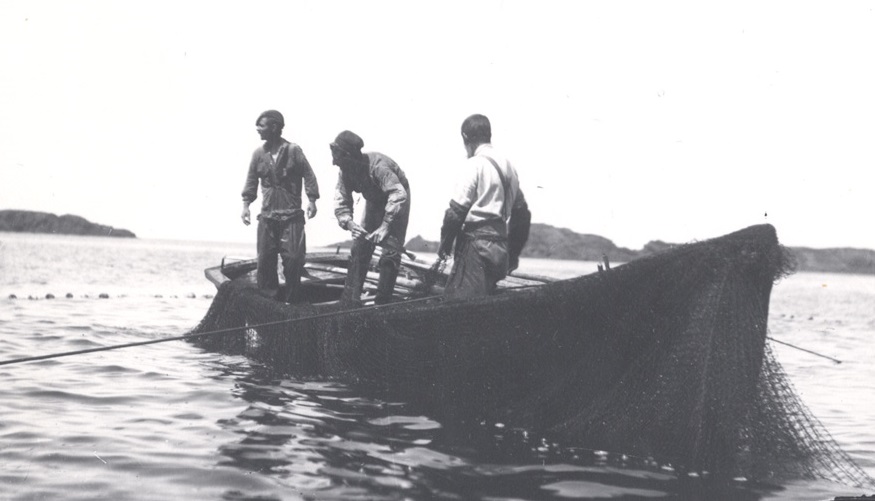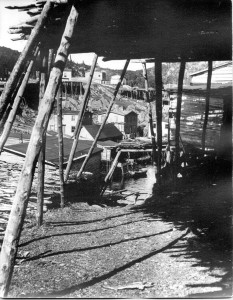Una sea song tradizionale di Terranova (in inglese Newfoundland), l’isola di fronte alla costa orientale del Canada. E’ stata raccolta da Kenneth Peacock e Gerald S Doyle e pubblicata nel “Folk Songs of Canada”, 1954 (anche nella raccolta di Gerald S Doyle “Old-Time Songs of Newfoundland,” 1955) per diventare popolare in tutto il paese.
I’SE THE B’Y
Si tratto di una canzoncina apparentemente non-sense sulla vita di una comunità di pescatori, ma che leggendo tra le righe (ovvero con il Dizionario di Terranovese in mano) un po’ di senso, ossia di doppio-senso ce l’ha!

ASCOLTA Great Big Sea 1993
I I’se the b’y(1) that builds the boat And I’se the b’y that sails her I’se the b’y that catches the fish (2) And brings ‘em home to Lizer(3) CHORUS Hip yer(4) partner, Sally Tibbo(5) Hip yer partner, Sally Brown(5) Fogo, Twillingate, Mor’ton’s Harbour(6) All around the circle II Sods and rinds(7) to cover yer flake (8) Cake (9) and tea for supper Cod-fish in the spring o’ the year Fried in maggoty butter III I don’t want your maggoty fish (10) They’re no good for winter I can buy as good as that Down in Bonavista IV I took Lizer to a dance And fast as she could travel And every step that she did take Was up to her knees in gravel(11) V Susan White she’s out of sight Her petticoat wants a border(12) Old Sam Oliver in the dark He kissed her in the corner |
Traduzione italiano di Cattia Salto I Sono io il tipo (1) che si costruisce la barca e ci naviga sopra, sono io il tipo che prende il pesce (2) e lo porta a casa da Liza. (3) CORO Gira (4) con il tuo compagno Sally Tibbo Gira con il tuo compagno Sally Brown (5) Fogo, Twillingate, Moreton’s Harbour(6) tutti in cerchio II Zolle di terra e rametti (7)per coprire la piattaforma per l’essiccazione (8) gallette (9) e tè per cena, merluzzo in primavera fritto nel burro rancido. III Non voglio il tuo pesce marcio (10) non va bene per l’inverno ne posso comprare di meglio giù a Bonavista. IV Ho preso Liza per un giro di danza il più veloce possibile, ma ad ogni passo che faceva si bloccava le ginocchia nella ghiaia(11) V Susan White è fuori vista la sua sottana ha bisogno dell’orlo (12), il vecchio Sam Oliver al buio la baciava nell’angolo. |
NOTE
1) “I’s the B’y” = I’m the Boy
2) con “fish” a Terranova ci si riferisce al baccalà
3) Liza. Le strofe giocano sul doppio senso di Lisa come donna oppure come il nome di una barca.
4) To hip =to bump someone on the hip when dancing; anche scritto Swing
5) Tibbo sta per Thibeault. I due cognomi ricordano che ci furono coloni francesi e inglesi nella zona in cui ha avuto origine la canzone
6) Fogo, Twillingate, Morton’s (o Moreton’s) Harbour sono villaggi sulle isole al largo delle coste Nord di Terranova, come se formassero le tappe di un percorso circolare che facevano le barche
7) The rindes = strips of birch bark placed on top of the fish to protect them from the sun so they don’t burn, and to keep blow-flies off so they don’t get maggoty. In realtà il cannicciato è posto sotto il pesce messo ad essiccare e le zolle di terra non hanno niente a che vedere con il processo di riparo e di essiccazione. Così alcune versioni riportano la strofa con dei termini comprensibili in inglese standard. In questa strofa era descritto un vecchio modo di lavorazione per essiccare il merluzzo in modo che le mosche non potessero deporre le loro larve e guastare il pesce.
Strofa alternativa:
Flour and crumbs to cover the fish,
Cake and tea for supper,
Cod fish in the spring o’ the year
Fried in rancid butter.
8) flake: una piattaforma costruita su pali per far essiccare il pesce
 “The first thing that strikes a stranger on entering a harbour in Newfoundland is the abundance of what are called the fish flakes and stages, together with the wooden wharfs and the great dark red storehouses. The fish flakes consist of a rude platform, raised on slender crossing poles, ten or twelve feet high, with a mating of sticks and boughs for a floor. On these the fish are laid out to dry, and planks are laid down along them in various directions, to enable the persons who have the care of the fish to traverse them…. and in a populous cove or harbour the whole neighbourhood of the houses is surrounded by these flakes, beneath whose umbrageous and odoriferous shade is frequently to be found the only track from one house to the other.” (da Jukes’ Excursions: Being a revised edition of Joseph Beete Jukes’ “Excursions in and about Newfoundland, During the Years 1839 and 1840.” ) Foto: Path under the flakes, La Manche ca. 1938. PANL VA7-45 (PANL-CMCS). tratto da qui
“The first thing that strikes a stranger on entering a harbour in Newfoundland is the abundance of what are called the fish flakes and stages, together with the wooden wharfs and the great dark red storehouses. The fish flakes consist of a rude platform, raised on slender crossing poles, ten or twelve feet high, with a mating of sticks and boughs for a floor. On these the fish are laid out to dry, and planks are laid down along them in various directions, to enable the persons who have the care of the fish to traverse them…. and in a populous cove or harbour the whole neighbourhood of the houses is surrounded by these flakes, beneath whose umbrageous and odoriferous shade is frequently to be found the only track from one house to the other.” (da Jukes’ Excursions: Being a revised edition of Joseph Beete Jukes’ “Excursions in and about Newfoundland, During the Years 1839 and 1840.” ) Foto: Path under the flakes, La Manche ca. 1938. PANL VA7-45 (PANL-CMCS). tratto da qui
9) cake: le gallette che facevano parte dell’equipaggiamento delle navi al posto del pane
10) magotty fish: pesce marcio infestato dalle larve
11) Gravel= pebble-strewn isthmus. Qui la frase è giocata sul doppio senso: potrebbe trattarsi di Liza che non riesce a saltare bene sulle ginocchia quando danza, ma anche della barca di nome Liza che si arena sulla ghiaia con i fondali bassi
12) come spesso accade nei canti tradizionali i riferimenti sessuali non sono mai espliciti, anche se tutti sanno a cosa si riferisce la frase
FONTI
http://www.wtv-zone.com/phyrst/audio/nfld/01/itb.htm
http://www.wtv-zone.com/phyrst/audio/nfld/25/itbgbs2.htm
http://www.joyhecht.net/6-08-15/Aug15-06.html
http://www.heritage.nf.ca/articles/exploration/eyewitness-accounts.php
http://www.therooms.ca/ic_sites/fisheries/main2.asp?frame=off
http://www.veneto.antrocom.org/blog/?p=1731
